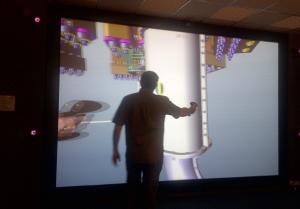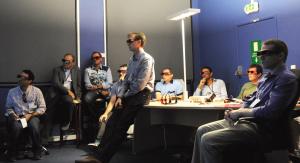MAM has a word to say
17 Sep 2013
-
Sabina Griffith
The model of the central solenoid, developed by the US Domestic Agency on the basis of functional specifications provided by the ITER Organization, reflects the final design proposed by the US after feedback from industry and manufacturing trials.
There is a procedure for everything ... and certainly more than one when it comes to building the world's largest fusion device. One of the procedures established within the ITER Organization is the Model Approval Meeting (MAM), in which the design descriptions for critical components pass the final check before they are turned into hardware.
The 3D-viewer room on the neighbouring premises of CEA Cadarache has become a regular meeting spot for ITER engineers over the last weeks and months. On one morning in late August, about a dozen ITER staff working on the central solenoid, the centrepiece of ITER's magnet system, have come together to review the compatibility of the detailed 3D CAD model provided by US Domestic Agency with the rest of the Tokamak. This model, developed by US ITER at Oak Ridge National Laboratory on the basis of the functional specifications provided by the ITER Organization, reflects the final design proposed by the US after feedback from industry and manufacturing trials.
The turn-to-turn spacing of the solenoid conductor had apparently been too tight to be guaranteed by the industrial manufacturer. The solution on the table, proposed by US ITER, is to extend the winding gaps by reducing the inner radius. The impact of this solution is the focus of the discussion.
Jens Reich, coordinator of tokamak design integration and leader of the meeting, asks the 3D-room operators to overlay the original configuration model developed by the ITER Organization with the detailed model they have received back from the US.
Equipped with 3D glasses, participants saw every detail of the real-size central solenoid come to life on the screen.
A few seconds later, through their 3D-glasses, observers saw a real-size, down-to-the-detail central solenoid unfold on the screen in front of them. What impact would the changes have? And what about the margins at the perimeter—would they still allow for the assembly of this supersized magnet? The central solenoid will be lowered into the machine at the very end of the assembly process, a procedure that doesn't leave much flexibility for manoeuvring.
The last word about the design of the central solenoid will have to wait until the Final Design Review planned for 18-20 November this year. "But this 3D-check is a very helpful tool to verify the details of a component and to identify any potential interface issues to be solved," explains Jean-Jacques Cordier, leader of the ITER Design Integration team, before he and his colleagues put their glasses on again to look at the next client, the support structures for the poloidal field coils.



